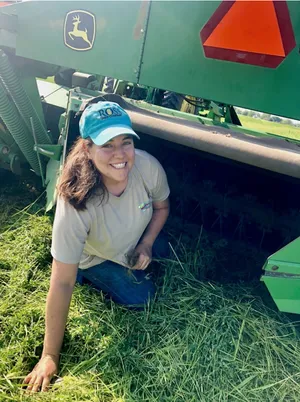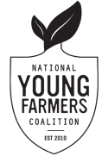Jean M. Lam is a Land Advocacy Fellow with the National Young Farmers Coalition and an operator of Lam Farms in Temple, in Cotton County. Her op-ed was first published in the Oklahoman in August 2022.
The pandemic revealed many unspoken truths about society in the United States, truths that many marginalized peoples have long known. The pandemic caused us to look inward and reevaluate our place and sense of belonging. A sense of disconnectedness and social isolation was common for many, which often led to an environment of disempowerment, a feeling new to most. Among these realizations was a great reconciliation concerning our understanding of work; it seems that we are moving beyond our traditional understanding of “work.”

Even in rural Oklahoma, where speaking openly about emotions has not been the generational norm, today farmers and ranchers are increasingly willing to explore what their involvement in agriculture means to them. While the generational commitment to maintaining a legacy is a popular motivating force, the personal, emotional fulfillment derived from growing and nurturing food and fiber for the world is becoming expressed more openly.
Without a doubt, there is an underlying commitment to individualism and self-reliance in agriculture and the rural way of life. This commitment is both a romanticized accolade to our lifestyle we wear with pride and also the unfortunate downfall of far too many. And yet despite our independence, our reliance on community is fundamental to the survival of agriculture and our role within; without consumers, our products are valueless. Without good neighbors, strong fences and generous friends to fall back on, agriculture would be nearly impossible.
I realize and value that my organizational involvement and membership is entirely dependent on the fact that individuals in those agricultural groups invited me and encouraged my participation. There are people in your community who could use such an invitation. Members of historically marginalized communities or as USDA defines, “SDFR” (Socially-disadvantaged Farmers, Ranchers or Agricultural Producers), have not had the same scale of inclusion and sense of community in the world of agriculture. A socially disadvantaged person belongs to a group whose members have been subject to racial or ethnic prejudice because of their identity — in regard to their individual qualities. Groups include Native Americans or Alaskan Native, Asians, Blacks Americans, Native Hawaiians or other Pacific Islanders, and Hispanics.
Successful Farming states that, “a third of America’s 3.4 million farmers are over 65, according to the most recent agricultural census from the U.S. Department of Agriculture. The census was taken in 2017 and published in 2019. At the time, nearly a million more farmers were within a decade of the milestone retirement age of 65.”
As the median age of farmers and ranchers is increasing, the United States is on the precipice of a historical shift in land ownership and management. Millions of acres will be transferred to new operators and owners in the next several decades. How we navigate this transition will determine the ability of marginalized groups to successfully enter into agriculture.
While the USDA has made, and continues to make, an effort to correct the systemic discrimination in their offices and programs, it falls to us — individual farmers — to create an inclusive community for all farmers and ranchers. I ask of you, my fellow producer, to turn inward and assess your effort to create an environment of inclusiveness. If you’ve ever driven down a remote gravel road and passed a place overgrown with eastern red cedars and remarked to yourself, “Wow, I wish that guy would get his cedars under control;” or thought, “My life would be a lot easier if my neighbor would stop overgrazing and build some cross fences to rotationally graze, then their cows might stay home,” pause and reflect on the barriers potentially inhibiting that neighbor from accessing programs through their local conservation district, Natural Resource Conservation Service (NRCS) office, or Farm Service Agency (FSA) service center. It could be lack of program awareness, lack of eligibility due to fractionated ownership issues, or a history of discrimination. What may seem like a rudimentary concept to you is just the beginning for others. Consider extending an invitation into a conversation about their land journey, their stewardship, their needs, and their goals. We all succeed when we all grow.
There are numerous factors at play that have impeded the growth of and access to land by SDFR producers. Systemic discrimination is an evident stain on American history that plays significantly into this narrative but we as industry stakeholders have the opportunity today to create more equity in agriculture.
Echoing back to my own sense of belonging in the agricultural world as a member of the Choctaw Nation of Oklahoma and a young beginning female farmer, I feel included because I was invited. Are we all not fundamentally fueled by a desire to belong? Whether it is to belong to our community, our church, or even within our own family, we as humans thrive on connectedness. My fellow farmer, I ask you to explore our common humanity and reposition your thinking about the true meaning of belonging. My call to you is to listen, to extend an invitation, and to amplify the voice of your fellow farmer, wherever they are in their land journey. The call being made upon agriculturalist to provide food and fiber for 7 billion people is a tremendous obligation that cannot be achieved without everyone at the table.
I’m an advocate for equitable land access and land practices because it takes all of us to create a sense of belonging and feed the world.
